Defining Self Service Absence Rules by Take Element
To define Take-specific self service absence rules, use the Country Take (GP_ABS_BAL_SS_DEF) component.
|
Page Name |
Definition Name |
Usage |
|---|---|---|
|
GP_ABS_ELIG_SS |
For a given Take element and country, define absence units (days or hours), who can submit and approve requests, what happens to cancelled requests, and whether to allow partial-day absences. You can also specify whether to display the absence reason and entitlement balances. |
|
|
GP_ABS_ELIG2_SS |
Define rules for entering absence dates, such as whether absences can begin or end on a holiday or off-day and whether to have the system calculate an absence's end date or duration. |
|
|
GP_ABS_ELIG3_SS |
Define user fields. |
|
|
GP_ABS_ELIG4_SS |
Define forecasting rules. |
|
|
View Messages Page |
GP_ABS_ELIG42_SEC |
View the default messages that are returned by the online forecasting process. |
|
GP_ABS_ELIG4_SEC |
Customize the messages that are returned by the online forecasting process. |
|
|
GP_ABS_ELIG5_SS |
Link configurable section templates to extended absence components and define access to the templates. |
Approval Process IDs determine how absence request submissions, approvals, denials, and requests for rework are routed among approvers, requesters, and absence administrators. Self service absence transactions that require action by a user appear in both user worklists and emails. The content of the email message is defined using the Generic Template pages in the PeopleTools Workflow Notifications component. Which email template is used depends on the user's role (approver, requester, or administrator), and the approval framework event.
PeopleSoft Absence Management delivers the following Approval Process IDs:
AbsenceManagement
AM_Extended_Abs
Email Notification Templates for Absence Management Self Service Transactions
The following table lists the email template names that are used for each role based on the approval framework event:
|
Approval Framework Event |
Requester Templates |
Approver Templates |
Administrator Templates |
Absence Request Action Button |
|---|---|---|---|---|
|
Launch |
GP_ABS_SS_SUB |
Submit |
||
|
Approve |
GP_ABS_SS_APPR_READY |
Submit |
||
|
OnApprove |
GP_ABS_SS_APPR |
GP_ABS_SS_APPR |
Approve |
|
|
OnDeny |
GP_ABS_SS_DNY |
GP_ABS_SS_DNY |
Deny |
|
|
Back |
GP_ABS_SS_WRK |
Needs Rework (Used when there are multiple levels of approval. For example, when Approver 2 pushes back to Approver 1.) |
||
|
Terminate |
GP_ABS_SS_WRK |
Needs Rework |
||
|
Error |
GP_ABS_SS_ERR |
NONE |
See the product documentation for PeopleTools: Workflow Technology.
Depending on the rules that you define, the system can automatically calculate the duration of an absence event or its end date when a user enters an absence request. Calculation occurs when the user clicks a button on the Request Absence page.
The following factors can affect the calculation of an absence duration or end date:
Partial-day absences.
Users can indicate whether partial-day absences apply to the first day of the absence event, all days, the last day, or the first day and the last day.
Absence Take formulas.
If the formulas that your organization has defined for absence Take processing do not recognize partial hours, users can enter partial-day absences, but they are not used in calculations.
Holidays and off days.
Specify to allow absence to start or end on a holiday or off day. Also, determine the calculation rule on the end date and/or duration.
Unit type.
If the unit type defined for the absence (in the Unit Type field on the Absence page) is days, partial hours recorded for an absence event are ignored by the duration and end date calculations.
Calculations for Absences with a Unit Type of Hours
When the unit type defined for the absence is hours, the system calculates the end date and duration of an absence event as follows:
End Date
To calculate the end date, the system applies the hours entered in the Duration field to the scheduled hours, day by day, starting with the begin date. Partial hours and half-days are taken into account. If there's a negative balance when the end date is reached (that is, scheduled hours for the end date exceed any remaining duration hours) the partial hours for the end date are adjusted to reflect the difference of hours.
An error is generated if the Apply to All Days check box is selected and the duration hours cannot be evenly divided by the partial hours or is not a sum of all scheduled hours divided by two, if half day is selected.
Duration
The system adds the scheduled hours for the requested absence dates and adjusts the sum for partial or 1/2 day absences.
Example 1: Calculating End Date
Assume an employee works eight hours each day from Monday to Friday. Saturday and Sunday are off days (zero hour). The employee entered an absence request with a begin date of Wed, January 07 and a duration of 24 hours. The absence take is defined in hours. The following table shows the system-calculated duration for various scenarios:
|
Start Date |
Duration |
Start Date Partial Hours |
1/2 Day Begin Date |
All Days |
End Date Partial Hours |
1/2 Day End Date |
End Date |
Comments |
|---|---|---|---|---|---|---|---|---|
|
01/07/2004 |
24 |
0 |
N |
N |
0 |
N |
01/09/2004 |
8 hrs/ Wed, Thu, Fri |
|
01/07/2004 |
24 |
3 |
N |
N |
5 |
N |
01/12/2004 |
3 hrs/ Wed (bgn day); 8hrs/2days; 0 hr/ Sat, Sun; 5hrs/ Mon (end day) |
|
01/07/2004 |
24 |
0 |
Y |
N |
4 |
N |
01/12/2004 |
4 hrs/Wed (bgn day); 8hrs/2days; 0 hr/Sat, Sun; 4hrs/ Mon (end day) |
|
01/07/2004 |
24 |
0 |
N |
Y / All Days Hrs: 4 Hrs |
0 |
N |
01/14/2004 |
4 hrs/Wed, Thu, Fri; 0 hr/Sat, Sun, 4hrs/Mon, Tue, Wed |
|
01/07/2004 |
24 |
0 |
N |
Y/ All Days are Half Days |
0 |
N |
01/14/2004 |
4 hrs/ Wed, Thu, Fri; 0 hr/ Sat, Sun, 4hrs/ Mon, Tue, Wed |
|
01/07/2004 |
24 |
0 |
N |
Y / All Days Hrs: 5 Hrs |
0 |
N |
Error |
24 not divisible by 5 |
|
01/07/2004 |
5 |
5 |
N |
N |
0 |
N |
01/07/2004 |
24 not divisible by 5 |
Example 2: Calculating Duration
Assume an employee works eight hours each day from Monday to Friday. Saturday and Sunday are off days (zero hour). The employee enters an absence request and provides the begin date and the end date. The absence take is defined in hours. The following table shows the system-calculated duration for various scenarios.
|
Start Date |
End Date |
State Date Partial Hours |
1/2 Day Begin Date |
All Days |
End Date Partial Hours |
1/2 Day End Date |
Duration |
Comments |
|---|---|---|---|---|---|---|---|---|
|
01/05/2004 |
01/08/2004 |
0 |
N |
N |
0 |
N |
32 |
8 hrs/ Mon, Tue, Wed, Thu |
|
01/05/2004 |
01/08/2004 |
3 |
N |
N |
0 |
N |
27 |
3 hrs/ Mon; 8hrs/ Tue, Wed, Thu |
|
01/05/2004 |
01/08/2004 |
0 |
N |
N |
3 |
N |
27 |
8hrs/ Mon, Tue, Wed; 3hrs/ Thu |
|
01/05/2004 |
01/08/2004 |
3 |
N |
N |
3 |
N |
22 |
3 hrs/ Mon; 8hrs/ Tue, Wed; 3hrs/ Thu |
|
01/05/2004 |
01/08/2004 |
0 |
N |
Y/All Days Hrs: 3 Hrs |
0 |
N |
12 |
3 hrs/ Mon, Tue, Wed, Thu |
|
01/05/2004 |
01/08/2004 |
0 |
Y |
N |
0 |
N |
28 |
4 hrs/ Mon; 8hrs/ Tue, Wed, Thu |
|
01/05/2004 |
01/08/2004 |
0 |
N |
N |
0 |
Y |
28 |
8hrs/ Mon, Tue, Wed; 4 hrs/ Thu |
|
01/05/2004 |
01/08/2004 |
0 |
Y |
N |
0 |
Y |
24 |
4 hrs/ Mon; 8hrs/ Tue, Wed; 4 hrs/ Thu |
|
01/05/2004 |
01/08/2004 |
0 |
N |
Y/All Days are Half Days |
0 |
N |
16 |
4 hrs/ Mon, Tue, Wed, Thu |
|
01/05/2004 |
01/10/2004 |
0 |
N |
N |
0 |
Y |
40 |
8hrs/ Mon, Tue, Wed, Thu, Fri; 0hr/ Sat |
|
01/04/2004 |
01/08/2004 |
0 |
Y |
N |
0 |
N |
32 |
0hrs/ Sun; 8hrs/ Mon, Tue, Wed, Thu |
|
01/04/2004 |
01/10/2004 |
0 |
N |
Y/All Days are Half Days |
0 |
N |
20 |
0hrs/ Sun; 4hrs/ Mon, Tue, Wed, Thu; 0hr/ Sat |
If you enable self service users to run the online Forecasting process, you can define the message to display at the end of that process. Use the Text Catalog to define the text for up to three messages: a success message, a warning message, and an error message. The entitlement element's forecasting formula specifies the conditions for issuing each message. You will map the value that's returned for each condition to the corresponding message that you define in the Text Catalog.
To define forecasting messages:
Use the Text Catalog to define a status message, a description, or both for each possible Forecasting outcome: success, warning, and error.
Use the Customize Messages page to map each message type (success, warning, error) to the value returned by the forecasting formula and to specify which text to display from the text catalog.
See Viewing or Modifying Text on Self Service Absence Pages.
Use the Country Take - Absences page (GP_ABS_ELIG_SS) to for a given Take element and country, define absence units (days or hours), who can submit and approve requests, what happens to cancelled requests, and whether to allow partial-day absences.
You can also specify whether to display the absence reason and entitlement balances.
Navigation
Image: Country Take - Absences page
This example illustrates the fields and controls on the Country Take - Absences page.
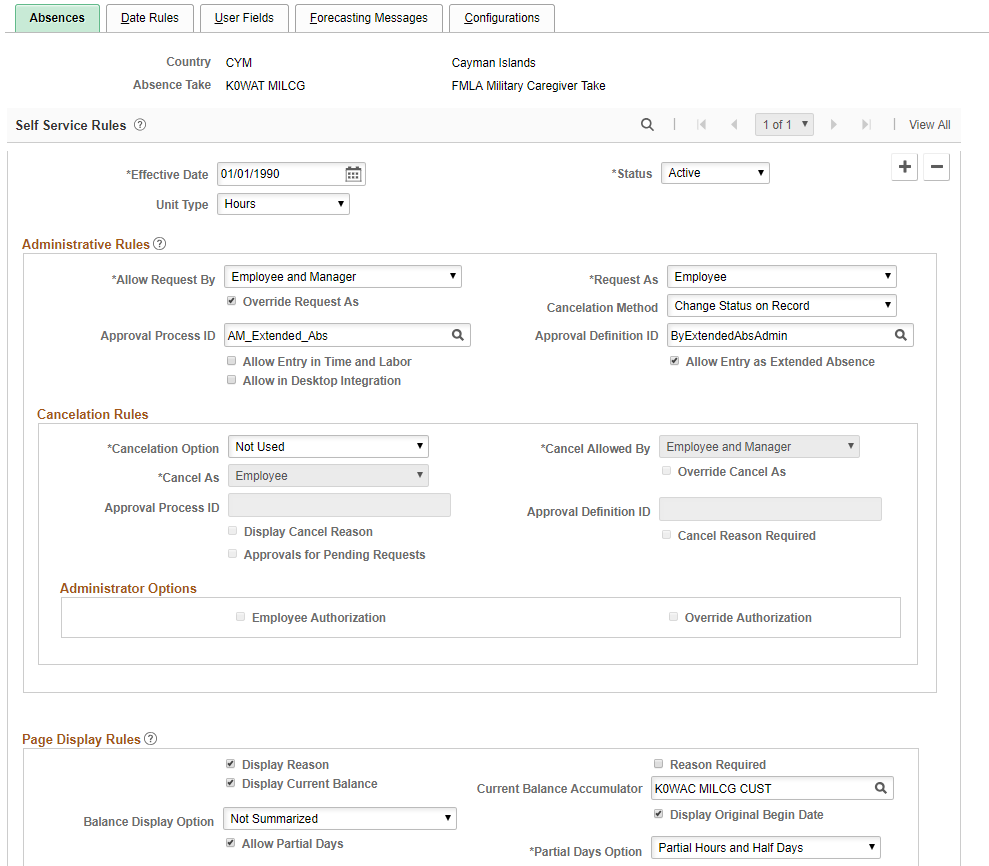
Self Service Rules
|
Field or Control |
Definition |
|---|---|
| Unit Type |
Select Days or Hours as the units to display on the self service pages. These are units that users enter when requesting time off. Note: The selected unit type should match the unit type defined for the Take element. |
Administrative Rules
|
Field or Control |
Definition |
|---|---|
| Allow Request By |
Specify who can request absences for this Take element through the self service pages. Values are: Employee, Employee and Manager (default), and Manager. |
| Request As |
Specify whether this Take element can be requested as an Employee, Manager, or is Not Applicable in the manager self service page. |
| Override Request As |
Specify whether the Request As option selected can be overridden on the manager self service page. |
| Approval Process ID |
Select the approval Process ID to use for the Country and absence take element. Approval Process ID refers to the technical definitions that control the execution of the approval process and its integration with the Approval Workflow Engine. In addition notifications (emails and worklist) are defined within Approval Process ID. |
| Approval Definition ID |
Select the ID that corresponds to this type of approval, based on how you set up the approval framework. PeopleSoft delivers one approval Definition ID that is used for six delivered Process IDs. The selection of Definition ID for the self service Take elements at the country level depends on how the company has set up Direct Reports. This field is optional. You can also set up Administrative Rules without entering a value in this field. If you define an absence Take without a Definition ID, the system does not use the approval framework when employees or managers select this Take element on absence self service pages. See Understanding the Approval Process. Note: If your absence request does not require approval, then leave Approval Process ID and Approval Definition ID blank. The absence request will be automatically approved once the user submits it. |
| Cancelation Option |
Specify what happens when an absence request is cancelled. Options are: Change Status on Record: (Default) Select to have the system change the status of the request to Cancelled. When a request's status is set to Canceled, you can no longer access the request. Delete from Database: Select to have the system delete the request from the database. |
| Allow Entry in Time and Labor |
Select to allow absence event entry on the Timesheets page in PeopleSoft Time and Labor. You cannot select both the Allow Entry in Time and Labor field and the Allow Entry as Extended Absence field. |
| Allow Entry as Extended Absence |
Select to enable users to choose this absence take as an extended absence. You cannot select both the Allow Entry in Time and Labor field and the Allow Entry as Extended Absence field. |
| Allow in Desktop Integration |
Select to enable users to choose this absence take when entering absence requests through the desktop integration with Microsoft Outlook. SeeEntering Absence Requests through Microsoft Outlook. |
Cancelation Rules
|
Field or Control |
Definition |
|---|---|
| Cancelation Option |
Specify which type of absence events can be canceled. Options are:
|
| Cancelation Allowed by |
Specify who can request absence cancelations for this take element through self-service pages. Options are:
|
| Cancel As |
For absence cancelation requests submitted using manager self-service pages, define who this take can be requested as. Values are:
|
| Override Cancel As |
Select whether the Cancel As value can be overridden on manager self-service pages. |
| Approval Process ID |
Select the approval Process ID to use for the Country and absence take element. Approval Process ID refers to the technical definitions that control the execution of the approval process and its integration with the Approval Workflow Engine. In addition notifications (emails and worklist) are defined within Approval Process ID. |
| Approval Definition ID |
Select the ID that corresponds to this type of approval, based on how you set up the approval framework. PeopleSoft delivers one approval Definition ID that is used for six delivered Process IDs. The selection of Definition ID for the self service Take elements at the country level depends on how the company has set up Direct Reports. This field is optional. You can also set up Administrative Rules without entering a value in this field. If you define an absence Take without a Definition ID, the system does not use the approval framework when employees or managers select this Take element on absence self service pages. See Understanding the Approval Process. Note: If your absence request does not require approval, then leave Approval Process ID and Approval Definition ID blank. The absence request will be automatically approved once the user submits it. |
| Display Cancel Reason |
Select to display the Cancel Reason field on the self-service pages. You define cancel reasons for specific absence take types. If you select this check box, the Cancel Reason Required check box becomes available. |
| Cancel Reason Required |
Select this check box to make it mandatory for users to select a cancel reason when canceling absence requests that use this take. |
| Approvals for Pending Requests |
With this check box deselected, employees do not need approval when they cancel pending absence requests. If you select this check box, requests to cancel pending absence requests require manager approval. |
Administration Options
|
Field or Control |
Definition |
|---|---|
| Employee Authorization |
Enabled if employee approval is required for these absences when admin submits the cancelation request. |
| Override Authorization |
Enabled if administrator needs to override employee authorization while cancelation. |
Page Display Rules
|
Field or Control |
Definition |
|---|---|
| Display Reason |
Select to enable self service users to specify the reason for the absence. This check box is selected by default. |
| Reason Required |
Select to require that users enter the reason for the absence. |
| Display Current Balance |
Select to display the balance for the absence entitlement element, as of the last finalized absence run on the Request Absence page. The balance will not reflect the number of units that the user is requesting. This check box is not selected by default. |
| Current Balance Accumulator |
If you selected the Display Current Balance check box, select the accumulator element that stores the current balance for this absence Take element. |
| Balance Display Option |
Indicate which value you want the system to display as the current balance, when there are multiple instances of the accumulator with different user keys. Select one of the following options: Not Summarized (default). Consider using this option when your rules for displaying the current balance are very complex. Create an accumulator that summarizes the value of the element contributors. The system will display the value of the most current instance of the accumulator. Summarized. Select this option to have the system display the sum of the values of the multiple instances. |
| Display Original Begin Date |
Select to display the Original Start Date field on the Request Absence page. |
| Allow Partial Days |
This check box works with the Partial Days Option field. Select it to indicate whether partial day absences are allowed. Do not select the check box if partial days or hours are not allowed. |
| Partial Days Option |
This field becomes available when you select the Allow Partial Days check box. Options are:
|
In the following example, the Summarized option would return a value of 20 for the KOAE PTO accumulator.
|
Accumulator |
From |
To |
User Key 1 |
User Key 2 |
Value |
|---|---|---|---|---|---|
|
KOAE PTO |
January 1, 2000 |
December 31, 2000 |
CIA A |
Pay group A |
5 |
|
KOAE PTO |
January 1, 2001 |
December 31, 2001 |
CIA A |
Pay group A |
8 |
|
KOAE PTO |
January 1, 2002 |
July 31, 2002 |
CIA B |
Pay group B |
4 |
|
KOAE PTO |
August 1, 2002 |
December 31, 2002 |
CIA B |
Pay group B |
2 |
|
KOAE PTO |
January 1, 2003 |
December 31, 2003 |
CIA B |
Pay group XYZ |
1 |
Use the Country Take - Date Rules page (GP_ABS_ELIG2_SS) to define rules for entering absence dates, such as whether absences can begin or end on a holiday or off-day and whether to have the system calculate an absence's end date or duration.
Navigation
Image: Country Take - Date Rules page
This example illustrates the fields and controls on the Country Take - Date Rules page.
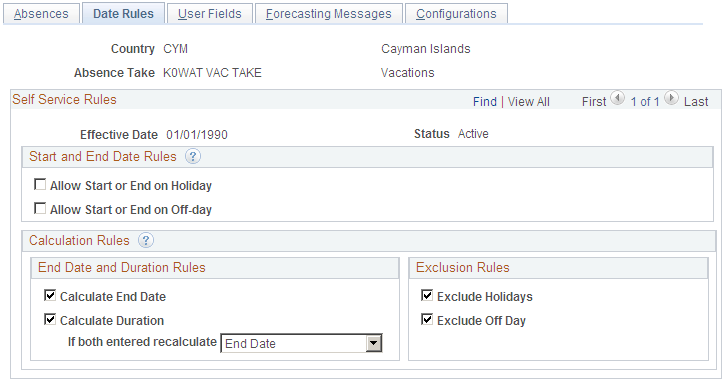
Start and End Date Rules
|
Field or Control |
Definition |
|---|---|
| Allow Start or End on Holiday |
Select if the start or end date of the request can fall on a holiday. This field is selected by default. |
| Allow Start or End on Off-day |
Select if the start or end date of the request can fall on a day the employee is not scheduled to work. This field is selected by default. |
Calculation Rules
The option that you select here causes a Calculate End Date button, a Calculate Duration button, or a Calculate End Date or Duration button to appear on the Request Absence page.
See Understanding Absence Duration and End Date Calculations.
|
Field or Control |
Definition |
|---|---|
| Calculate End Date |
Select to have the Calculate End Date button appear. When entering an absence request, the user must enter the absence begin date and duration. Clicking the Calculate End Date button causes the system to calculate and display the end date. This is the default selection. |
| Calculate Duration |
Select to have the Calculate Duration button appear. When entering an absence request, the user must enter the absence begin and end dates. Clicking the Calculate Duration button causes the system to calculate and display the duration. |
| If both entered recalculate |
This field controls what happens when a user enters a value in both the End Date and Duration fields while entering an absence request.
|
| Exclude Holidays |
Select to exclude holidays from the end date and duration calculation for requested absence events. |
| Exclude Off Day |
Select to exclude non-worked days (based on the employee's schedule) from the end date and duration calculation for requested absence events. |
Use the Country Take - User Fields page (GP_ABS_ELIG3_SS) to define user fields.
Navigation
Image: Country Take - User Fields page
This example illustrates the fields and controls on the Country Take - User Fields page.
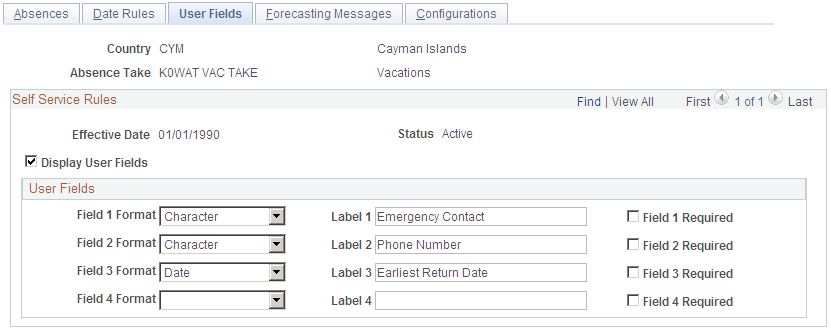
|
Field or Control |
Definition |
|---|---|
| Display User Fields |
Select to have up to four user-defined fields appear on the Request Absence page. |
User Fields
Define up to four fields to appear on the Request Absence page. These fields enable you to collect additional data that you may need for absence tracking. You can use these fields as system elements and embed them in rules to perform a specific task with the information that users enter.
For each field you define, specify the format, the field label, and whether users are required to complete the field.
|
Field or Control |
Definition |
|---|---|
| Field <number> Format |
Options are Character, Date, Decimal, and Monetary. |
| Label <number> |
Enter up to 30 alphanumeric characters for the field name. To appear on the Absence Detail page, the field must have a label. |
| Field <number> Required |
Select if users are required to complete the field. |
Use the Country Take - Forecasting Messages page (GP_ABS_ELIG4_SS) to define forecasting rules.
Navigation
Image: Country Take - Forecasting Messages page
This example illustrates the fields and controls on the Country Take - Forecasting Messages page.
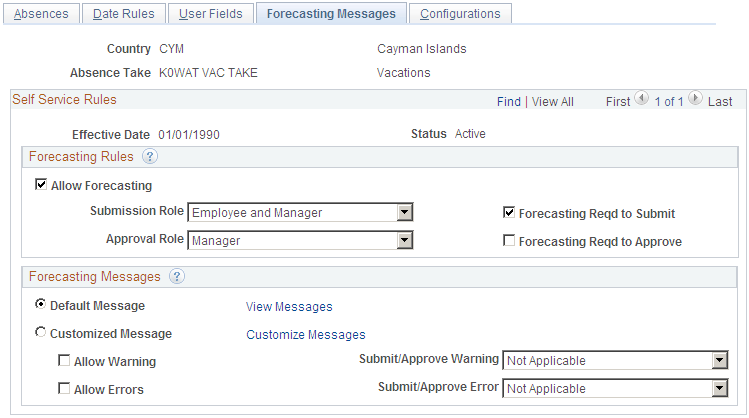
Forecasting Rules
|
Field or Control |
Definition |
|---|---|
| Allow Forecasting |
Select to enable self service users to run the online forecasting process. A Forecast Balance button will appear on the Request Absence page. This check box is not selected by default. Note: For self service users to run the forecasting process, the country rules for that Take element must also allow forecasting. (The Forecast Request Enabled check box must be selected on the Forecasting Grid page.) |
| Submission Role |
If forecasting is required before submitting an absence request, specify who must run the process. Options are: Employee, Manager, Employee and Manager, and Not Applicable(default). This field works in conjunction with the Forecasting Reqd to Submit check box. If you select the Forecasting Reqd to Submit check box, then you must specify a role in this field. |
| Forecasting Reqd to Submit (forecasting required to submit) |
Select to require that the Forecasting process be run before submitting an absence request. This check box is not selected by default. Depending on your rules, the results of the forecasting process may determine whether or not the request can be submitted. Users receive an error message when they click Submit on the Absence Request page without first forecasting the absence entitlement balance. |
| Approval Role |
If forecasting is required, specify who can run the forecasting process. Options are: Manager and Not Applicable. |
| Forecasting Reqd to Approve (forecasting required to approve) |
Select to require that the online forecasting process be run before approving an absence request. |
Forecasting Messages
The system can display the message, “Forecasting Completed Successfully” at the end of the forecasting process, or it can display customized messages that you create. You can have a different message display when the forecasting process is successful, generates a warning, or results in an error. You define the criteria for issuing a success, warning, or error message.
|
Field or Control |
Definition |
|---|---|
| Default Message and View Messages |
Select to have the system display the default message after a user runs the forecasting process. Click the View Messages link to access the View Messages page to see the default message. There is a default message for successful forecasting and one for system error. |
| Customized Message |
Select to have a customized message display after a user runs the online forecasting process. |
| Allow Warning and Submit/Approve Warning |
Select to enable users to submit absence requests when the forecasting process results in a warning. In the Submit Warning field, specify who can submit requests with warnings. Options are: Employee, Manager, Employee and Manager (default), and Not Applicable. |
| Allow Errors and Submit/Approve Error |
Select to enable users to submit absence requests when the forecasting process results in an error. In the Submit Error field, specify who can submit requests with errors. Options are: Employee, Manager, Employee and Manager (default), and Not Applicable. |
Use the Customize Messages page (GP_ABS_ELIG4_SEC) to customize the messages that are returned by the online forecasting process.
Navigation
Click the Customize Messages link on the Forecasting Messages page.
Image: Customize Messages page
This example illustrates the fields and controls on the Customize Messages page.

|
Field or Control |
Definition |
|---|---|
| Message Type |
Select the type of message to define: Error, Success, or Warning. |
| Forecasting Value |
Enter the value that the Forecasting process (the forecasting formula) will return to trigger the display of this message. You can enter up to 20 alphanumeric characters in this field (the maximum field length for a character element in Absence Management). |
| Display Option |
Specify the type of information in the Text Catalog that is to display after forecasting is complete. Options are: Status, Description and Both (default). |
| Status Text ID |
If you selected Display Status or Both in the Display Option field, enter the text ID from the HR Text Catalog for the status message. |
| Description Text ID |
If you selected Display Description or Both in the Display Option field, enter the text ID from the HR Text Catalog for the description. |
Use the Country Take - Configurations page (GP_ABS_ELIG5_SS) to link configurable section templates to extended absence components and define access to the templates.
Navigation
Image: Country Take - Configurations page
This example illustrates the fields and controls on the Country Take - Configurations page.
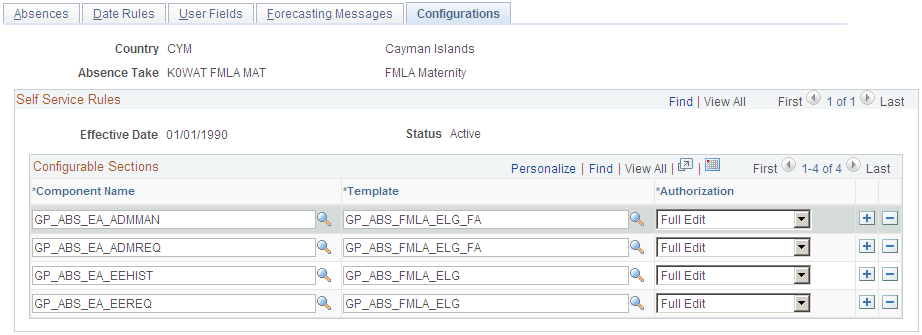
|
Field or Control |
Definition |
|---|---|
| Component Name |
Select an extended absence component that will link to a configurable section page to link to the configurable section template. |
| Template |
Select a defined configurable section template. |
| Authorization |
Select the access mode used by the extended absence request to access the configurable section template. The values are Full Edit and Display. |
In order to display configurable section information for user self-service, link the configurable section templates you created to each of the extended absence components you are using. Then specify the desired type of user access to the displayed configurable section page.
For example, using the information shown in the Configurations page graphic, when a user accesses the GP_ABS_EA_EEREQ extended absence component, using the Cayman Islands FMLA maternity absence take, the GP_ABS_FMLA_ELG template specifies the composition of the displayed configurable section page. The users accessing the configurable section page have full edit access on the displayed page.